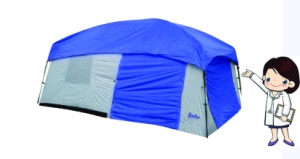Most often, when people return from an exhausting camping trip, the last thing they want
to do is clean all of the gear they took with them. Being out in the wilderness and lacking the effective cleaning supplies we are accustomed to seeing in the cupboard underneath our kitchen sinks, often only the “quick clean” of gear is done, and it tends to be left that way once we return home. But good enough doesn’t always cut it – think of the money you spent on your equipment and what it would cost to replace if not properly cared for. Check out our advice for how to best clean your gear and with what products to ensure it lasts as long as possible, continuing to assist you on adventurous camping trip s for years to come.
s for years to come.
Boots
The best way you can guarantee your boots will be kept in great shape is to make sure you take 10-20 minutes cleaning them up after each trip. First, remove the laces and insoles, if they are removable. Start with warm water and a small brush (a firm-brush toothbrush will do) that is able to reach into the cracks and crevices of the boots, and start brushing. If a small brush is just not cutting it, browse more specialized tools meant for boot cleaning. When the obvious dirt has been removed, rinse the brush and go over the boots again, but this time with warm water and a boot cleaner. If none is available, a mild dish soap will do. Stay away from laundry detergent or bar soap, as they can damage the boots through residue. Allow the boots to dry in room temperature. Many people use the quick-dry method of drying their boots next to a fire or in the hot sun, but this can cause the leather to become brittle and the adhesive parts of the boot to wear out. The best way to dry them quickly is to place them in front of a fan. If you don’t have a fan, REI suggests using newspapers that are shoved in each boot, which work to absorb excess moisture. Place boots upside down during drying, as this speeds up the process. Once the boots are dry, make sure to use a conditioner coating if they are looking cracked. Also, waterproof boots after each use. Many people want to remove the smell from their boots, so place each in a large, sealed bag and keep them in the freezer for 48 hours, which will kill the bacteria causing the stink. Store boots in a spot where the temperature remains constant, keeping them in perfect condition until your next adventure.
Cooking Supplies
Cleaning your camping cookware is a little less time consuming that caring for your footwear, but still just as important when it comes to preserving your gear. We all do the quick clean on cookware during camping trips, but spending time actually getting rid of the bacteria and grime when you get home is crucial. Fill each pot and pan with hot water and add several drops of soap – use biodegradable if you’re out on the trail doing the once-over clean. Make sure to use any kind of soap, even if it is biodegradable, at least 200 feet away from water sources. Scrub the inside of each several times using a rough sponge or pot scrubber. Rinse the pots with clean water and put them aside to dry. In the case of cooking supplies, the at-home deep clean is pretty obvious, but as for on-the-trail advice, place your cookware in separate pockets of your pack or wrap them in bags to avoid the blackened bottom of pots and pans from staining other equipment.
Tent
Making sure your tent lasts a long life starts the first time you set it up at a campsite. Ensure there are no objects below the tent such as rough plants, rocks, or roots, because this is the number one way tents are destroyed. This isn’t to say you just tear any vegetation to make room for your tent, but rather find a space that has even, clean ground that is already in existence. Making sure the bottom of your tent is also protected on the inside is another thing to think about. Consider purchasing a footprint, which is a barrier between your feet and the bottom of the tent that covers the entire surface of the floor. In addition, make sure the tent is taught when securing it with stakes to prevent any area becoming a catch basic for water or other debris. Make a habit of not wearing shoes inside the tent, and that should help to keep dirt and debris outside, but still make sure to sweep or shake it out several times when you’re done. Another alternative is to use a PahaQue Tent Rug to help keep your tent clean. Something else people don’t consider as often when setting up camp is that most tents are made of nylon, which is worn away by the sun. Try to set up the tent in a shaded area to prolong its life. When packing the tent away at home, the most imperative factor of whether or not it will last is if it’s dry or not. Set up the tent when you get back home and use a non-abrasive sponge, cold water, and a non-detergent soap to clean the inside and outside. Any cleaning products with a perfume smell will attract bugs. Once it is fully dry, pack away in a room temperature, dry location.





